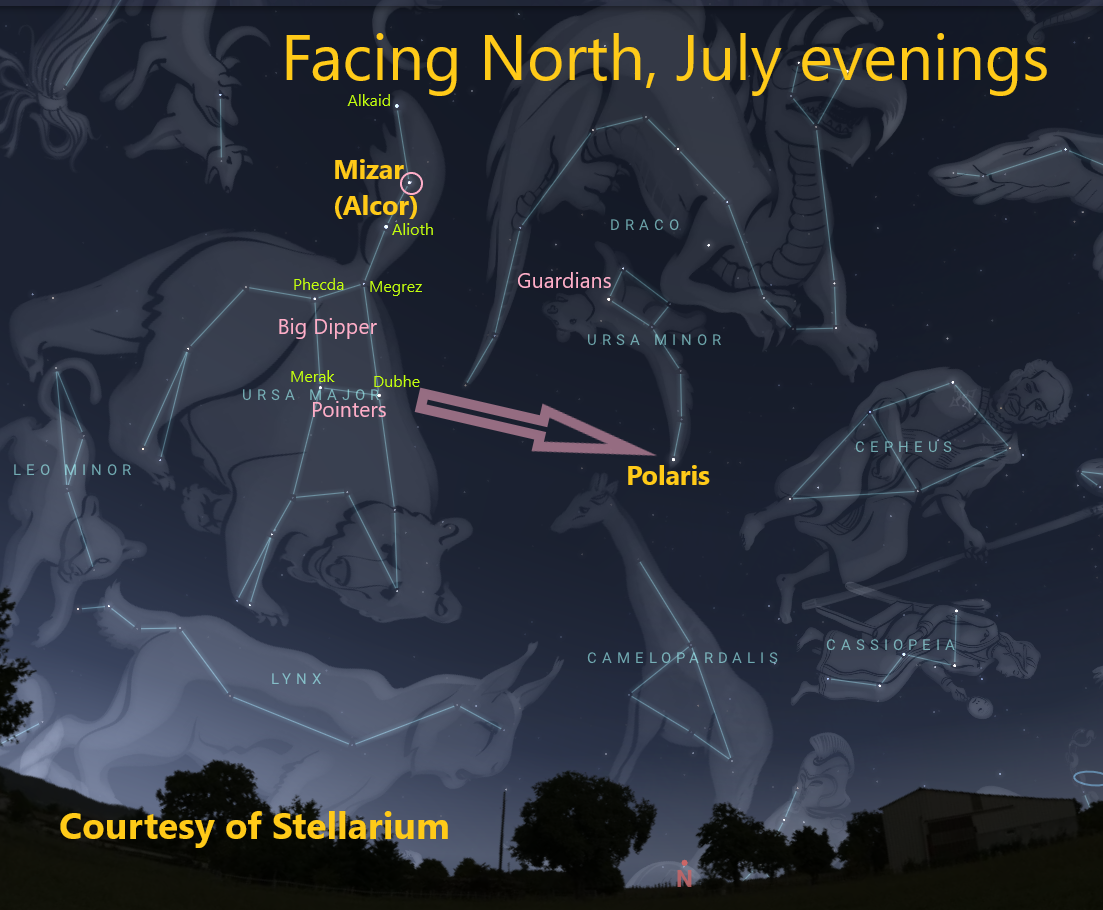THE GREAT BEAR

The huge constellation Ursa Major, or the Great Bear, in our summer night sky.
The seven fairly bright stars that make up the Big Dipper are very well known. Three stars form the handle, and four the bowl. It is also pretty well known that a line drawn through Merak and Dubhe, the two stars in the Big Dipper’s bowl farthest from the handle (the pointers) always points to Polaris, also known as the North Star. The night sky appears to revolve around Polaris, as it appears almost directly above the North Pole of the Earth. During summer evening hours, the Big Dipper appears to the left of Polaris, as shown above. Three months from now the Big Dipper will be close to the northern horizon during Fall evenings and may be partly blocked by landscape objects. In the winter, the Dipper is to the right of Polaris, and above it in the spring.
Six of the stars in the Big Dipper are of similar brightness, ranked second magnitude. This is bright enough to be seen even through light pollution, unless they are quite low in the sky. However, Megrez, the stars that joins the bowl and handle together, is noticeably fainter at third magnitude, and can be hard to see if the night is hazy or the sky too bright. Five out of the seven are roughly 80 light years from Earth and are believed to have all formed together, about 300 million years ago and still travel together through space. Alkaid and Dubhe, are more than 100 light years away and are just in the same line of sight as the other members of the Big Dipper.
The most noteworthy star of all in the Big Dipper is Mizar, the star at the bend in the handle. When I was much younger, on a clear dark night, with my glasses on or contacts in, I could often see fourth magnitude Alcor very close to Mizar, even from close to the city. Unfortunately, time marches on, and now in my seventh decade, I haven’t been able to see Alcor with my unaided eyes in several years. Can you spot it yourself without optical aid? It is easy in binoculars. Mizar and Alcor are both members of the Ursa Major Association (described above) so they are traveling together through space at a distance of about 1.5 trillion miles apart, but it is not known for sure if they are actually gravitationally tied to one another. Mizar and Alcor have long been considered a test of vision, and there is a Japanese tradition of them being the “Lifespan Star”- if you can’t see Alcor, it is a sign of impending death due to old age. Uh-Oh!!!
If you have a small telescope, aim it at Mizar. You will instantly see Alcor as well close by, but a close look will show that Mizar itself is a binary star. Analysis of the light of Mizar A, Mizar B, and Alcor in a spectroscope shows that each star has its own very close companion, unresolvable directly with any telescope. Imagine that- the one star you see at first glance at the bend in the Big Dipper’s handle is actually the combined light of at least six stars!
As famous as the Big Dipper is, it is not one of the 88 recognized constellations in the night sky. It is what is called an asterism, a small part of the huge constellation Ursa Major, the Great Bear. As you can see from the image, the stars of the Big Dipper form the Bear’s tail. Unfortunately, the other stars in the constellation are much dimmer and are hard to see from light polluted areas. You can try to bring binoculars and trace out the entire group if you don’t have access to a dark sky. Polaris, the North Star, marks the end of the tail of Ursa Minor, the Lesser Bear, also called the Little Dipper. Much like Ursa Major, the stars of much of Ursa Minor are faint and hard to see from areas with significant light pollution but reveal themselves with the help of binoculars. The two stars in the Little Dipper’s bowl farthest from the handle are a bit brighter and stand out better. They are known as the Guardians of the Pole.
The stars of Ursa Major are recognized as a bear in the sky lore of many cultures. In the Greek and Roman tradition, King Zeus (Jupiter) had his way with the nymph Callisto, and they had a son named Arcas. Although Callisto was in no way at fault, the jealous wife Hera (Juno) transformed her into a bear. No longer recognizing her, Arcas nearly killed his mother while hunting, and Zeus sent them both into the sky to avoid any more trouble.
Would you like to learn even more about the stars, constellations, and planets visible in this summer’s night sky, and some of the stories behind them? You might enjoy “Summer Stargazing”- a free program that will be held in our Education Classroom at 7 pm on July 12. Weather permitting, this planetarium type program will be followed by free telescope viewing on the Park’s Education Classroom.
